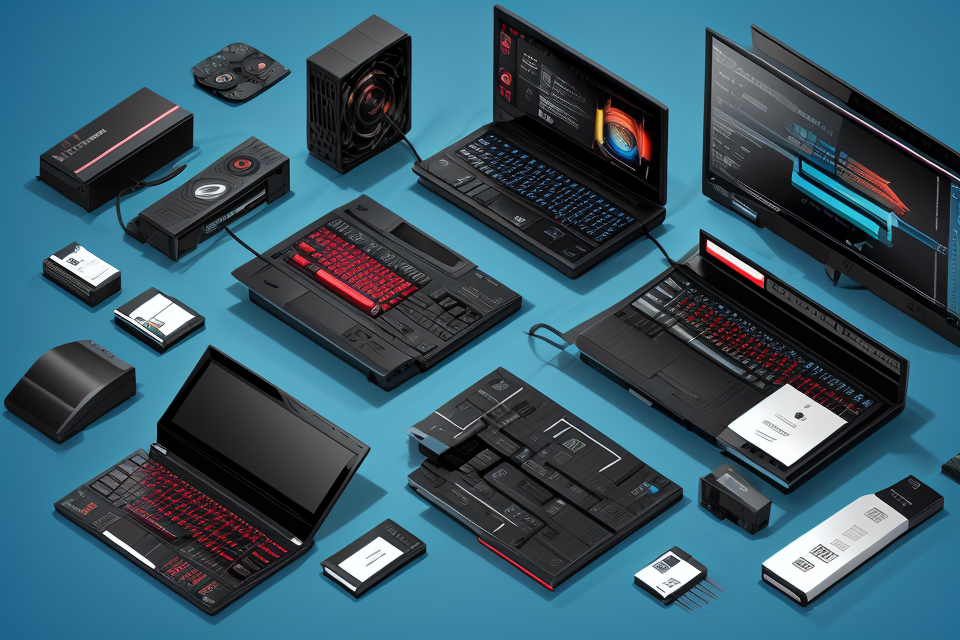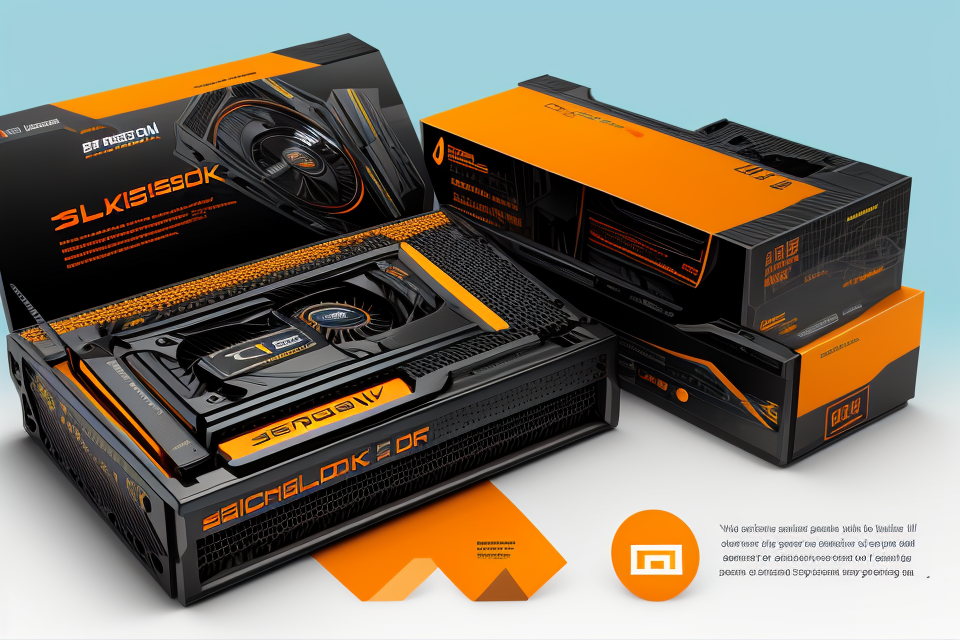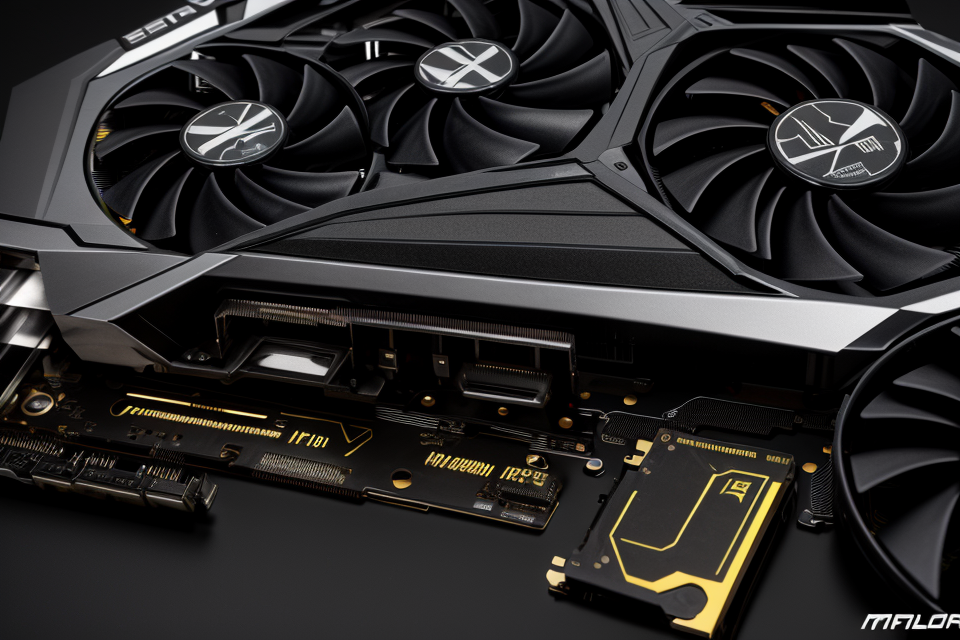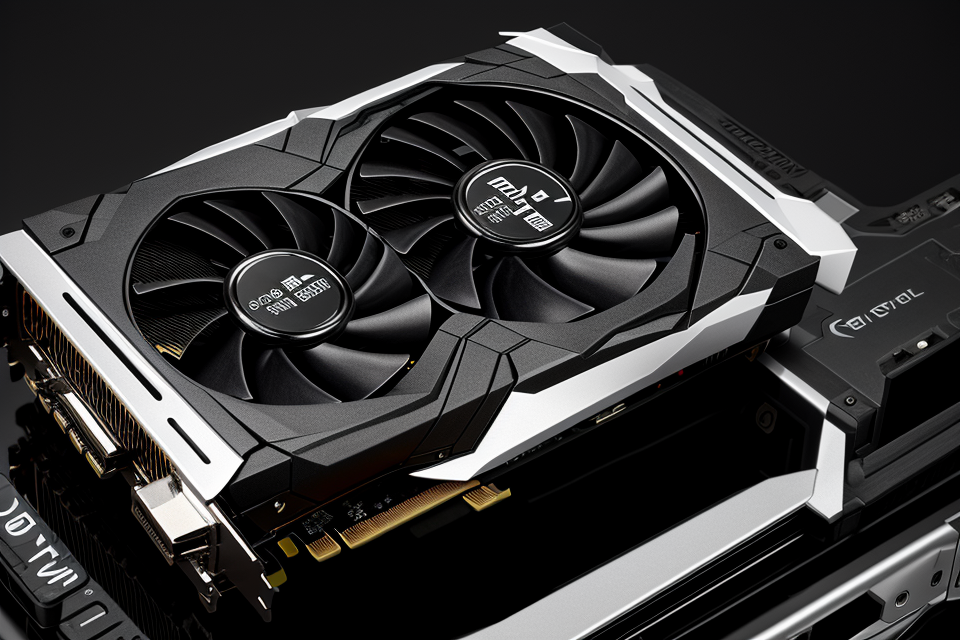
Are you struggling to decide which graphics card to buy? With so many options available in the market, choosing the right GPU can be overwhelming. But fear not! This comprehensive guide will help you make an informed decision. We will cover everything from the basics of graphics cards to the factors that affect their performance. By the end of this guide, you will have a clear understanding of what to look for when purchasing a graphics card, and you will be able to choose the one that best suits your needs. So, let’s dive in and explore the world of graphics cards!
Factors to Consider When Choosing a Graphics Card
Budget
When it comes to choosing a graphics card, one of the most important factors to consider is your budget. The price of a graphics card can vary greatly, and it’s important to set a budget before making a purchase.
Different price ranges for graphics cards offer different levels of performance and features. For example, entry-level graphics cards may be sufficient for basic gaming and general computing tasks, while high-end graphics cards may offer more advanced features and better performance for demanding applications such as gaming, video editing, and 3D modeling.
It’s important to note that a higher price does not always mean better performance. It’s important to do your research and compare different models and brands to find the best graphics card for your needs and budget.
When setting a budget, it’s important to consider not only the cost of the graphics card itself, but also any additional costs such as shipping, taxes, and installation. It’s also important to consider the cost of any other components that may need to be upgraded in order to properly utilize the graphics card, such as a power supply or cooling system.
In conclusion, setting a budget before purchasing a graphics card is crucial in order to find the right card that meets your needs and budget. By doing your research and comparing different models and brands, you can find the best graphics card for your needs and budget.
System Compatibility
When choosing a graphics card, it is important to consider the compatibility of the card with your current system. To do this, you should take into account the motherboard and power supply requirements of the card.
- Motherboard Requirements: The motherboard of your computer must have an available PCIe slot for the graphics card to be installed. Additionally, the motherboard must have sufficient power to support the card. It is important to check the motherboard manual or manufacturer’s website to confirm compatibility.
- Power Supply Requirements: The power supply unit (PSU) of your computer must be able to provide enough power to the graphics card. Most graphics cards require a minimum power supply wattage, usually listed on the card’s specifications. It is important to check the PSU’s wattage and compare it to the minimum requirement of the card.
To check the compatibility of a graphics card with your current system, you can use online tools such as PCIe Compatibility Tool or GPU-Z. These tools can provide information on the card’s compatibility with your motherboard and power supply. Additionally, it is recommended to consult the manufacturer’s website for any additional information or guidance on compatibility.
Gaming Needs
Determine the Specific Gaming Needs of the User
When choosing a graphics card, it is essential to consider the specific gaming needs of the user. The first step in determining these needs is to identify the type of games that the user plans to play. For example, if the user intends to play graphically intensive games such as first-person shooters or racing games, they will require a more powerful graphics card than someone who primarily plays casual games.
Explain How Different Graphics Cards Perform in Different Types of Games
Once the specific gaming needs of the user have been identified, it is important to consider how different graphics cards perform in different types of games. For instance, some graphics cards may perform better in games that require fast-paced action, while others may excel in games that require intricate details and textures. It is essential to research and compare the performance of different graphics cards in the games that the user plans to play to ensure that the correct one is chosen.
Additionally, the user’s budget should also be taken into consideration when choosing a graphics card. While high-end graphics cards can provide the best gaming experience, they also come with a higher price tag. It is important to balance the user’s gaming needs with their budget to ensure that the right graphics card is chosen.
Other Uses
When choosing a graphics card, it’s important to consider not just gaming but also other uses such as video editing and graphic design. Here’s a closer look at how different graphics cards perform in these tasks:
Video Editing
Video editing requires a lot of processing power, especially when working with high-resolution videos. A powerful graphics card can help speed up the rendering process and allow for smoother playback and editing. Nvidia’s Quadro series and AMD’s Radeon Pro series are popular choices for video editing, offering high performance and advanced features such as real-time ECG (electronic color grade) and stereoscopic 3D support.
Graphic Design
Graphic design also benefits from a powerful graphics card, as it can help with tasks such as rendering 3D models, working with large files, and applying complex effects. Some popular graphics cards for graphic design include Nvidia’s Quadro K420 and K620, and AMD’s Radeon Pro WX 2100 and WX 4100. These cards offer high performance and support for a wide range of design software, including Adobe Photoshop and Illustrator.
Overall, when choosing a graphics card for other uses such as video editing and graphic design, it’s important to consider factors such as performance, compatibility with software, and advanced features. Popular choices include Nvidia’s Quadro and Radeon Pro series, as well as AMD’s Radeon Pro series.
Types of Graphics Cards
Integrated vs. Discrete Graphics Cards
When it comes to choosing a graphics card, one of the first decisions you’ll need to make is whether to go with an integrated or discrete graphics card. Both types of cards have their own advantages and disadvantages, and understanding these differences is key to making an informed decision.
Integrated Graphics Cards
Integrated graphics cards are those that are built into the motherboard of your computer. They are typically less powerful than discrete graphics cards, but they do not require any additional installation or setup. Integrated graphics cards are often sufficient for basic tasks such as web browsing, document editing, and video playback. However, they may not be able to handle more demanding tasks such as gaming or video editing.
Discrete Graphics Cards
Discrete graphics cards, on the other hand, are separate devices that are installed in your computer’s PCIe slot. These cards are more powerful than integrated graphics cards and are designed specifically for tasks such as gaming, video editing, and other graphics-intensive applications. Discrete graphics cards require additional power and cooling, and they may also require additional installation and setup.
Pros and Cons of Integrated Graphics Cards
- Pros:
- Integrated graphics cards are less expensive than discrete graphics cards.
- They require no additional installation or setup.
- They consume less power and produce less heat than discrete graphics cards.
- Cons:
- They are less powerful than discrete graphics cards.
- They may not be able to handle demanding tasks such as gaming or video editing.
- They may not be upgradable or replaceable.
Pros and Cons of Discrete Graphics Cards
+ Discrete graphics cards are more powerful than integrated graphics cards.
+ They are designed specifically for <strong>demanding tasks such as gaming</strong> and video editing.
+ They can be upgraded or replaced as needed.
+ They are more expensive than integrated graphics cards.
+ They require additional power and cooling.
+ They may require additional installation and setup.
In conclusion, the choice between an integrated or discrete graphics card depends on your specific needs and the tasks you plan to use your computer for. If you are primarily using your computer for basic tasks such as web browsing and document editing, an integrated graphics card may be sufficient. However, if you plan to use your computer for more demanding tasks such as gaming or video editing, a discrete graphics card may be necessary.
Brand and Model Options
When it comes to choosing a graphics card, there are many brands and models to choose from. Some of the most popular brands include NVIDIA, AMD, and Intel. Each brand offers a range of products at different price points, with varying levels of performance.
NVIDIA is a well-known brand that is known for its high-end graphics cards. Their flagship product is the GeForce RTX series, which is designed for gamers and content creators who demand the highest levels of performance. These cards are typically expensive but offer cutting-edge features and technologies.
AMD is another popular brand that offers a range of graphics cards. Their flagship product is the Radeon RX series, which is designed for gamers and content creators who want a balance of performance and affordability. AMD’s graphics cards are often seen as a more budget-friendly alternative to NVIDIA’s high-end offerings.
Intel is a lesser-known brand in the graphics card market, but they offer a range of integrated graphics cards that are built into their CPUs. These cards are typically less powerful than dedicated graphics cards from NVIDIA and AMD, but they can still handle basic tasks such as web browsing and video playback.
When choosing a graphics card, it’s important to consider your budget and your needs. High-end graphics cards are designed for demanding tasks such as gaming and content creation, while entry-level graphics cards are better suited for basic tasks such as web browsing and video playback. Mid-range graphics cards offer a balance of performance and affordability, making them a popular choice for many users.
It’s also important to consider the features and technologies offered by each brand and model. For example, NVIDIA’s GeForce RTX series offers real-time ray tracing and AI-powered graphics, while AMD’s Radeon RX series offers support for FreeSync technology for smooth gaming experiences.
Ultimately, the right graphics card for you will depend on your specific needs and budget. By researching the different brands and models available, you can find the perfect graphics card to meet your needs.
Desktop vs. Laptop Graphics Cards
When it comes to choosing a graphics card, one of the first decisions you’ll need to make is whether to go with a desktop or laptop graphics card. Both types of graphics cards have their own unique advantages and disadvantages, and the right choice for you will depend on your specific needs and usage scenarios.
Desktop Graphics Cards
Desktop graphics cards are designed for use in desktop computers and are typically more powerful than their laptop counterparts. They are typically larger and require more power, but they also offer more flexibility in terms of customization and upgradability.
Some of the key advantages of desktop graphics cards include:
- Higher performance: Desktop graphics cards are typically more powerful than laptop graphics cards, which means they can handle more demanding tasks and games.
- More flexibility: Desktop graphics cards are easier to upgrade and replace, which means you can easily swap out an old card for a newer, more powerful model as your needs change.
- Better cooling: Because desktop graphics cards are larger and have more surface area, they can be easier to cool than laptop graphics cards. This means they are less likely to overheat and can run at higher speeds for longer periods of time.
However, there are also some disadvantages to consider:
- Size: Desktop graphics cards are larger and require more space, which can be a concern if you have a small form factor computer or limited desk space.
- Power consumption: Desktop graphics cards require more power than laptop graphics cards, which can lead to higher energy bills and the need for a more powerful power supply.
- Price: Desktop graphics cards are often more expensive than laptop graphics cards, especially high-end models.
Laptop Graphics Cards
Laptop graphics cards are designed specifically for use in laptops and are typically smaller and more power-efficient than their desktop counterparts. They are also more portable, which makes them a good choice for gamers who want to play on the go.
Some of the key advantages of laptop graphics cards include:
- Portability: Laptop graphics cards are smaller and lighter than desktop graphics cards, which makes them easier to take with you on the road.
- Power efficiency: Laptop graphics cards are designed to be more power-efficient than desktop graphics cards, which means they can help extend battery life and reduce heat output.
-
Integration: Many laptop graphics cards are integrated into the motherboard, which means they don’t require additional power or cooling.
-
Performance: Laptop graphics cards are typically less powerful than desktop graphics cards, which means they may not be able to handle as demanding tasks or games.
- Upgradability: Laptop graphics cards are often integrated into the motherboard, which means they can’t be easily upgraded or replaced.
- Heat: Because laptop graphics cards are smaller and have less surface area, they can be more prone to overheating than desktop graphics cards.
Ultimately, the right choice between a desktop and laptop graphics card will depend on your specific needs and usage scenarios. If you need a powerful graphics card for gaming or other demanding tasks, a desktop graphics card may be the better choice. If you’re looking for a more portable option or don’t need the highest levels of performance, a laptop graphics card may be a good choice.
How to Choose the Right Graphics Card for Your Needs
Research and Compare
When it comes to choosing the right graphics card for your needs, research and comparison are key. By taking the time to explore your options and compare different models, you can make an informed decision that will meet your needs and fit within your budget. Here are some tips on where to find information about graphics cards:
- Manufacturer websites: The websites of graphics card manufacturers such as NVIDIA and AMD provide detailed specifications and performance data for their products. This is a good place to start your research and compare the features and capabilities of different models.
- Online reviews: Online tech review websites such as AnandTech, TomsHardware, and TechSpot provide in-depth reviews of graphics cards, including benchmarks and real-world tests. These reviews can give you a better idea of how a particular graphics card will perform in different scenarios.
- User forums: Online forums such as Reddit’s r/PCbuilding and r/Amd are great resources for getting opinions and advice from other users. You can ask questions, read reviews, and compare different models to help you make an informed decision.
- Benchmarking tools: Tools such as 3DMark and Unigine Heaven and Superposition can help you benchmark the performance of different graphics cards and compare their performance side-by-side.
By taking the time to research and compare different graphics cards, you can find the one that best meets your needs and budget.
Assess Your Needs
When it comes to choosing the right graphics card, it’s important to assess your needs. This involves understanding what you want to use your graphics card for and how much you’re willing to spend. Here are some steps to help you assess your needs:
- Determine Your Use Case
The first step in assessing your needs is to determine your use case. Are you a gamer looking to play the latest games at high settings? Are you a content creator who needs a graphics card for video editing or graphic design? Or are you looking to use your graphics card for other purposes, such as machine learning or scientific simulations?
Once you know your use case, you can start to prioritize your needs. For example, if you’re a gamer, you’ll want to prioritize high frame rates and smooth gameplay. If you’re a content creator, you’ll want to prioritize performance in applications such as Adobe Premiere Pro or Photoshop.
- Determine Your Budget
The next step is to determine your budget. Graphics cards can range from affordable options that offer basic performance to high-end models that can cost thousands of dollars. It’s important to set a budget before you start shopping so that you can narrow down your options and find a graphics card that fits your needs and budget.
- Research Different Graphics Cards
Once you know your use case and budget, it’s time to research different graphics cards. Start by looking at the performance specifications of each card, such as the number of CUDA cores or stream processors. You should also consider other factors such as memory size, clock speed, and power consumption.
It’s also important to research the reviews of each graphics card to see how well it performs in real-world scenarios. Look for reviews from reputable sources such as PC Gamer, Tom’s Hardware, or TechRadar.
- Consider Compatibility
Finally, it’s important to consider compatibility when choosing a graphics card. Make sure that the card is compatible with your motherboard and power supply, and that it has enough PCIe slots for your other components. You should also consider the size of the card and whether it will fit in your case.
In summary, assessing your needs is an important step in choosing the right graphics card. By determining your use case, budget, and researching different options, you can find a graphics card that meets your needs and budget.
Consider Future Upgrades
When choosing a graphics card, it’s important to consider future upgrades. As technology advances, you may want to upgrade your graphics card to take advantage of new features and capabilities. Here are some tips for choosing a graphics card that will still be compatible with future technology:
- Look for a graphics card with a high amount of VRAM. VRAM (Video Random Access Memory) is used to store image data while it’s being processed by the graphics card. The more VRAM a graphics card has, the more image data it can store, which can be useful for running demanding games or applications that require a lot of graphics processing.
- Choose a graphics card with a high number of CUDA cores or Stream processors. CUDA (Compute Unified Device Architecture) is a parallel computing platform and programming model developed by NVIDIA. It allows developers to write programs that can run on NVIDIA GPUs. The more CUDA cores a graphics card has, the more calculations it can perform in parallel, which can improve performance.
- Look for a graphics card with a high clock speed. The clock speed of a graphics card refers to the number of cycles per second that the GPU can perform. A higher clock speed means that the graphics card can perform more calculations per second, which can improve performance.
- Consider a graphics card with support for new technologies like Ray Tracing or Variable Rate Shading. These technologies can improve the realism and visual quality of your games and applications, but not all graphics cards support them. If you plan on using these technologies in the future, make sure to choose a graphics card that supports them.
By considering these factors, you can choose a graphics card that will still be compatible with future technology and provide the performance you need for your applications and games.
Don’t Skimp on Quality
Choosing a high-quality graphics card is crucial to ensure that your computer runs smoothly and efficiently. While it may be tempting to save money by opting for a cheaper graphics card, this decision could lead to long-term problems and reduced performance.
Investing in a high-end graphics card offers several benefits. Firstly, it can improve the overall performance of your computer, especially when it comes to graphically intensive tasks such as gaming or video editing. A high-end graphics card can handle complex graphics and animations with ease, resulting in smoother gameplay and more realistic visuals.
Additionally, a high-end graphics card can increase the lifespan of your computer. By providing the necessary power to run demanding applications, it can prevent your computer from slowing down or crashing over time. This means that you can continue to use your computer for longer without encountering any issues.
Furthermore, a high-end graphics card can future-proof your computer. As technology advances, new software and games require increasingly powerful graphics cards to run smoothly. By investing in a high-end graphics card now, you can ensure that your computer will be able to handle the demands of future applications and games.
Overall, while it may seem like a unnecessary expense, investing in a high-quality graphics card is essential for optimal computer performance and longevity. Don’t skimp on quality when choosing a graphics card, as it will ultimately pay off in the long run.
FAQs
1. What is a graphics card and why do I need one?
A graphics card, also known as a GPU (Graphics Processing Unit), is a specialized component in a computer that is responsible for rendering images and videos. It is essential for tasks such as gaming, video editing, and graphic design. Without a graphics card, your computer would be unable to handle these tasks and would likely experience significant slowdowns or crashes.
2. What factors should I consider when choosing a graphics card?
When choosing a graphics card, there are several factors to consider. The most important factor is the intended use of the computer. For example, if you plan to use your computer for gaming, you will need a graphics card with enough power to handle the latest games. If you plan to use your computer for graphic design or video editing, you will need a graphics card with a high memory capacity. Other factors to consider include the card’s size, power consumption, and compatibility with your computer’s motherboard and power supply.
3. How do I know what type of graphics card I need?
To determine what type of graphics card you need, you should consider the intended use of your computer. If you plan to use your computer for gaming, you will need a high-performance graphics card with a high clock speed and a lot of video memory. If you plan to use your computer for graphic design or video editing, you will need a graphics card with a high memory capacity. It is also important to consider the power consumption of the card and whether it is compatible with your computer’s motherboard and power supply.
4. What are some popular graphics card brands?
There are several popular graphics card brands on the market, including NVIDIA, AMD, and Intel. NVIDIA is known for its high-performance gaming cards, while AMD is known for its value-oriented cards that offer good performance at a lower price point. Intel also offers graphics cards, but they are generally less powerful than those from NVIDIA and AMD. It is important to research and compare the different brands to find the one that best meets your needs.
5. How do I install a graphics card in my computer?
Installing a graphics card in your computer can be a complex process, and it is recommended that you seek assistance from a professional or follow a detailed guide. Generally, you will need to open your computer’s case, disconnect the old graphics card, and connect the new card according to the manufacturer’s instructions. It is important to make sure that the card is properly seated in the PCIe slot and that all connections are secure. Once installed, you will need to restart your computer and configure the card’s settings in the BIOS or through software.


